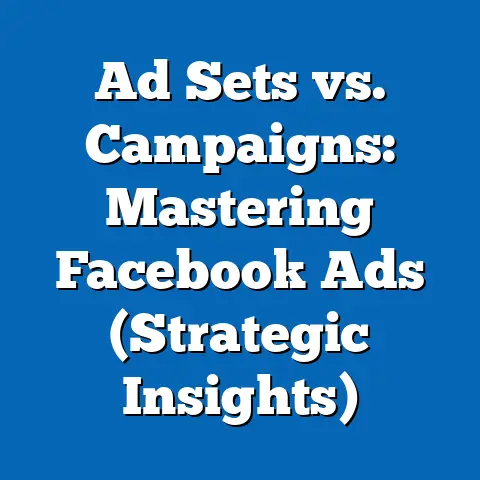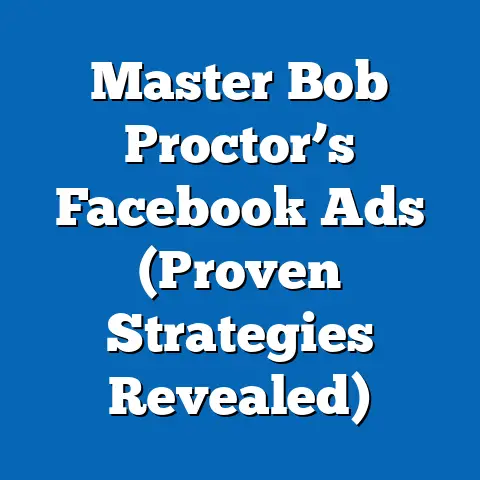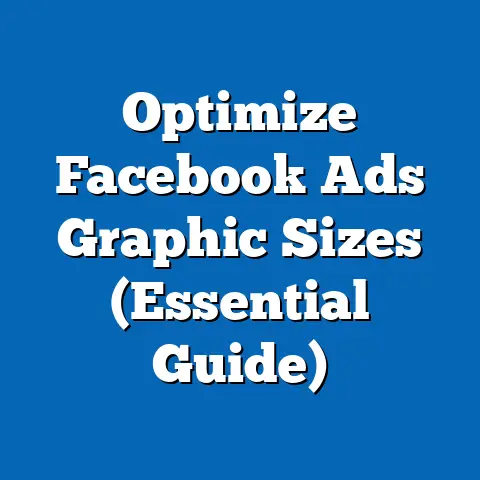Reduce CPM in Facebook Ads (Essential Strategies Revealed)
In an era where technology permeates every aspect of daily life, smart homes have emerged as a transformative trend, reshaping how individuals interact with their living spaces. According to a report by Statista, the global smart home market is projected to reach $141 billion by 2023, with a compound annual growth rate (CAGR) of 13.5% from 2018 to 2023. This rapid adoption reflects a growing consumer demand for convenience, security, and energy efficiency, driven by devices like smart thermostats, security cameras, and voice assistants.
Demographically, smart home technology is particularly popular among younger, tech-savvy generations. A 2022 survey by Pew Research Center found that 54% of Millennials (ages 26-41) own at least one smart home device, compared to 41% of Gen X (ages 42-57) and just 27% of Baby Boomers (ages 58-76). This trend is also geographically concentrated in urban areas, where higher disposable incomes and access to high-speed internet facilitate adoption.
Interestingly, the rise of smart homes has implications beyond consumer behavior—it also influences digital marketing strategies. As more households integrate smart devices, advertisers on platforms like Facebook must adapt to reach these tech-forward audiences effectively. One critical metric in this space is Cost Per Mille (CPM), which measures the cost of 1,000 ad impressions. High CPM rates can erode campaign budgets, making optimization a priority for marketers targeting smart home enthusiasts and beyond. This article explores essential strategies to reduce CPM on Facebook Ads, contextualized within the broader trends of smart home adoption and digital engagement.
Understanding CPM in Facebook Ads: The Basics
Before diving into optimization strategies, it’s essential to define CPM and its role in digital advertising. CPM, or Cost Per Mille, represents the cost an advertiser pays for every 1,000 impressions of their ad on Facebook. Unlike Cost Per Click (CPC), which focuses on user interactions, CPM is purely about visibility, making it a key metric for brand awareness campaigns.
According to a 2023 report by WordStream, the average CPM for Facebook Ads across industries is approximately $7.19, though this varies widely by sector. For instance, technology and consumer electronics—categories closely tied to smart home products—often see higher CPMs, averaging around $9.68 due to competitive bidding for niche audiences. Understanding these benchmarks is crucial for advertisers aiming to optimize costs.
Facebook calculates CPM based on an auction system, where advertisers bid for ad placements. Factors influencing CPM include audience targeting, ad relevance, competition, and seasonality. For marketers targeting smart home users, who often fall into high-income, tech-savvy demographics, competition can drive CPMs upward, necessitating strategic approaches to cost reduction.
Why Reducing CPM Matters for Marketers
High CPM rates can significantly impact advertising budgets, especially for small businesses or startups in the smart home sector. For example, if a company spends $10 per 1,000 impressions and aims for 1 million impressions, the cost balloons to $10,000—a hefty sum for limited visibility. Reducing CPM even by a dollar per 1,000 impressions can save thousands over a campaign’s lifespan.
Moreover, lowering CPM allows advertisers to stretch budgets further, reaching larger audiences or reinvesting savings into other marketing channels. This is particularly relevant for smart home brands, where building awareness among niche, tech-focused consumers is often the first step before driving conversions. Efficient CPM management ensures that every dollar spent maximizes exposure.
Beyond budget efficiency, a lower CPM often correlates with higher ad relevance and audience engagement, as Facebook rewards well-performing ads with better placement at lower costs. Thus, optimizing CPM isn’t just about cost-cutting—it’s about improving overall campaign effectiveness.
Historical Trends in Facebook Ad Costs
To contextualize current CPM challenges, it’s helpful to examine historical trends in Facebook advertising costs. In 2017, the average CPM on Facebook was around $5.12, as reported by AdEspresso. By 2020, this figure had risen to $7.34, reflecting increased competition as more businesses shifted to digital platforms during the COVID-19 pandemic.
Post-2020, CPM trends have fluctuated due to factors like Apple’s iOS 14 privacy updates, which limited ad tracking capabilities, and growing global adoption of social media advertising. A 2022 analysis by Socialinsider noted a slight dip in average CPM to $6.89 during non-peak seasons, though holiday periods like Q4 often see spikes of 20-30% due to heightened competition.
For smart home advertisers, these trends highlight the importance of timing and adaptability. As CPM costs have generally trended upward over the past five years, strategic planning—such as avoiding peak seasons or leveraging off-peak discounts—becomes critical to maintaining cost efficiency.
Demographic Patterns in Smart Home Audiences and Ad Targeting
Understanding the demographics of smart home users is key to crafting effective, low-CPM Facebook Ad campaigns. As noted earlier, Millennials are the primary adopters, with 54% owning smart devices per Pew Research. This group values convenience and sustainability, often seeking products like smart thermostats (e.g., Nest) or voice assistants (e.g., Amazon Alexa).
Geographically, smart home adoption is highest in North America, which accounts for 34.5% of the global market share, according to Statista’s 2023 data. Within the U.S., urban dwellers in states like California and New York show higher penetration rates due to income levels and tech infrastructure. Income also plays a role—households earning over $75,000 annually are twice as likely to own smart devices compared to those earning under $30,000.
For advertisers, these patterns suggest a need for hyper-targeted campaigns. Narrowing audience parameters to specific age groups (e.g., 25-40), locations (urban centers), and interests (technology, home improvement) can reduce CPM by minimizing wasted impressions on irrelevant users. However, over-targeting risks limiting reach, so a balance must be struck.
Essential Strategies to Reduce CPM in Facebook Ads
With the context of smart home trends and CPM basics established, let’s explore actionable strategies to lower CPM on Facebook Ads. These approaches are grounded in data and best practices, tailored to resonate with tech-savvy audiences while optimizing costs.
1. Refine Audience Targeting for Relevance
One of the most effective ways to reduce CPM is by ensuring ads reach the most relevant audience. Facebook’s algorithm prioritizes ad relevance, lowering costs for campaigns with high engagement rates. Start by using detailed targeting options—focus on demographics like age (25-45 for smart home buyers), interests (smart technology, home automation), and behaviors (recent home purchases).
For instance, a 2022 case study by Hootsuite showed that campaigns with tightly defined audiences saw a 23% lower CPM compared to broader targeting. Leverage Facebook’s Lookalike Audiences to mirror existing customers, further refining reach. Avoid overly broad or generic audiences, as they dilute relevance and increase costs.
Additionally, exclude irrelevant segments. If promoting high-end smart security systems, exclude low-income demographics or renters unlikely to invest in such products. This precision minimizes competition for impressions and drives down CPM.
2. Optimize Ad Creative for Engagement
Ad creative directly impacts CPM, as engaging content boosts relevance scores, reducing costs. According to Facebook’s own data, ads with high relevance scores (8-10 on a 1-10 scale) can see CPM reductions of up to 30%. Focus on visuals and messaging that resonate with smart home users—think sleek device imagery, lifestyle benefits (e.g., energy savings), and clear calls-to-action (CTAs).
Video ads often outperform static images, with a 2023 Sprout Social report noting that video content achieves 12% higher engagement rates on Facebook. For smart home products, short demos (15-30 seconds) showcasing device functionality can captivate audiences. Test multiple ad variations using A/B testing to identify top performers and allocate budgets accordingly.
Don’t overlook ad copy. Highlight pain points (e.g., high energy bills) and solutions (e.g., smart thermostats saving 10-15% on heating costs, per Energy Star). High engagement signals to Facebook that your ad deserves better placement at a lower cost.
3. Leverage Ad Placement and Timing
Ad placement and scheduling significantly influence CPM. Facebook offers placements across its ecosystem—News Feed, Stories, Marketplace, and Audience Network. News Feed placements often have higher CPMs (averaging $8.50 per WordStream) due to visibility, while less competitive placements like Marketplace can cost 20-30% less.
Experiment with automatic placements initially, allowing Facebook’s algorithm to optimize for cost efficiency. Over time, analyze performance data in Ads Manager to identify low-cost placements and manually adjust. For smart home ads, Stories may resonate with younger audiences, offering lower CPMs than traditional feeds.
Timing also matters. CPMs often spike during holidays—AdEspresso reports a 25% increase in Q4. Schedule campaigns during off-peak periods (e.g., early January or mid-summer) to capitalize on lower competition. Dayparting—running ads during specific hours—can further reduce costs; for instance, target evenings when smart home users are likely browsing after work.
4. Improve Ad Frequency and Avoid Fatigue
Ad frequency, or how often a user sees your ad, impacts CPM. High frequency can lead to ad fatigue, reducing engagement and increasing costs. A 2021 study by Socialbakers found that CPM rises by 15% when frequency exceeds 5 impressions per user over a week.
Monitor frequency in Facebook Ads Manager and set caps if necessary. Retargeting campaigns, common for smart home products, are prone to fatigue—users who’ve seen an ad multiple times may ignore it. Refresh creative regularly (every 7-10 days) to maintain interest without overexposing audiences.
Balance reach and frequency by expanding audience pools periodically. Introduce new Lookalike Audiences or test broader interest categories to keep impressions fresh while maintaining relevance. This approach prevents cost spikes from oversaturation.
5. Utilize Budget Optimization and Bidding Strategies
Facebook’s Campaign Budget Optimization (CBO) can lower CPM by distributing budgets to top-performing ad sets automatically. A 2023 experiment by Buffer showed that CBO campaigns achieved a 19% lower CPM compared to manual budget allocation. Enable CBO for campaigns with multiple ad sets to let the algorithm prioritize cost-effective delivery.
Bidding strategy also plays a role. Opt for “Lowest Cost” bidding over “Target Cost” for awareness campaigns, as it prioritizes cheaper impressions. However, monitor performance—lowest cost bidding can sometimes compromise quality. For smart home ads, where brand perception matters, ensure impressions align with target demographics even at slightly higher costs.
Set realistic daily budgets to avoid exhausting funds early in competitive auctions. Gradual increases in budget (10-20% daily) prevent sudden CPM spikes, as noted in Facebook’s best practice guidelines. Consistent pacing ensures stable costs over time.
6. Focus on Retargeting and Warm Audiences
Retargeting existing website visitors or engaged users often yields lower CPMs, as these “warm” audiences are more likely to interact with ads. Per a 2022 report by Criteo, retargeting campaigns on Facebook see CPMs 17% lower than cold audience campaigns due to higher relevance.
Install the Facebook Pixel on your website to track visitors interested in smart home products. Create Custom Audiences for users who viewed specific product pages (e.g., smart lighting) or added items to carts. Retarget with tailored offers—discounts or bundled deals—to boost engagement at reduced costs.
Layer retargeting with dynamic ads showcasing previously viewed products. Dynamic ads can reduce CPM by 10-15%, per Facebook’s internal data, by automating personalization. Warm audiences require less spend to convert, freeing budget for broader awareness efforts.
7. Monitor and Optimize for Seasonality
Seasonality affects CPM, particularly for smart home products tied to specific times of year (e.g., smart thermostats in winter). Data from Nanigans indicates that CPMs can increase by 30-50% during peak shopping seasons like Black Friday or Christmas. Plan campaigns outside these windows when possible.
Alternatively, capitalize on micro-seasons relevant to smart homes. For example, promote security cameras during summer vacation periods when homeowners prioritize safety. A 2023 analysis by HubSpot found that niche seasonal campaigns had 18% lower CPMs than generic holiday ads due to reduced competition.
Use historical data in Ads Manager to identify cost trends specific to your audience. Adjust budgets and creative to align with low-CPM periods, ensuring maximum efficiency. Proactive planning mitigates the impact of seasonal spikes.
Data Visualization: CPM Trends Across Industries
To illustrate CPM variations, imagine a bar chart comparing average CPMs across industries in 2023. Technology and consumer electronics top the list at $9.68, followed by retail at $8.45 and health/beauty at $7.90, per WordStream data. At the lower end, education and non-profits average $5.30 and $4.80, respectively.
This visual would highlight the competitive nature of tech-related advertising, relevant to smart home brands. A line graph overlaying CPM trends from 2017-2023 could further show the upward trajectory of costs, with notable spikes in 2020 and Q4 each year. Such visualizations underscore the need for strategic cost management in high-competition sectors.
Broader Implications and Future Trends
Reducing CPM on Facebook Ads is not merely a tactical exercise—it reflects broader shifts in digital advertising and consumer behavior. As smart home adoption grows (projected to reach 478.2 million households globally by 2025, per Statista), competition for tech-savvy audiences will intensify, potentially driving CPMs higher. Marketers must stay agile, leveraging data-driven targeting and creative innovation to maintain efficiency.
Moreover, privacy regulations and platform changes, like Apple’s App Tracking Transparency, will continue to challenge ad personalization, indirectly affecting CPM. A 2023 eMarketer report predicts that CPMs may rise by 10-15% over the next two years as tracking becomes harder, pushing advertisers to focus on first-party data and contextual targeting.
For smart home brands, the intersection of technology and lifestyle offers unique opportunities. By aligning ad strategies with user needs—convenience, security, sustainability—marketers can achieve lower CPMs while building brand loyalty. The future of advertising lies in balancing cost efficiency with meaningful engagement, ensuring that every impression counts.
Conclusion
Reducing CPM in Facebook Ads requires a multifaceted approach, from precise audience targeting and engaging creative to strategic timing and budget optimization. For smart home advertisers, understanding demographic trends—such as Millennials’ 54% adoption rate—and market dynamics is critical to crafting cost-effective campaigns. Historical data shows CPMs rising from $5.12 in 2017 to $7.19 in 2023, underscoring the urgency of optimization in competitive sectors.
By implementing the seven strategies outlined—refining targeting, optimizing creative, leveraging placement, managing frequency, using CBO, retargeting, and monitoring seasonality—marketers can achieve significant cost savings. These tactics not only lower CPM but also enhance campaign performance, aligning with broader trends in digital marketing and smart home growth. As technology evolves, so too must advertising strategies, ensuring relevance and efficiency in an increasingly connected world.






